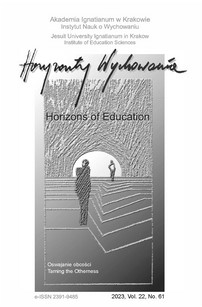Wybrane aspekty religijności u osób z niepełnosprawnością ruchową
Selected Aspects of Religiosity in People with Physical Disabilities
Author(s): Ewa Jaglarz, Agnieszka PopielSubject(s): Sociology of Religion, Psychology of Religion
Published by: Uniwersytet Ignatianum w Krakowie
Keywords: the people with disabilities; physical disabilities; religiosity; sense of life; psychology of religion;
Summary/Abstract: RESEARCH OBJECTIVE: The purpose of the study was to show selected aspects of religiosity in the context of disability or lack of it – its status in the lives of people with disabilities and the personal or non-personal nature of the relationship with God. THE RESEARCH PROBLEM AND METHODS: The main research problem was to determine what overall scores people with physical disabilities obtained on the Centrality of Religiosity Scale and the Personal Relationship to God Scale in comparison with people without disabilities, and what scores they obtained in such dimensions of religiosity as beliefs, prayer, updated relationship, mutual relationship and dialogical relationship, and in the dimension of cult and interest dimensions compared to people without disabilities. Dedicated scales, and a self-constructed survey questionnaire, were used to verify the formulated hypotheses. THE PROCESS OF ARGUMENTATION: The article discusses the issue of religion and religiosity on psychological grounds, in particular, its role and function that it can play in the lives of people with illnesses and disabilities. It was examined with the use of data statistical analysis, whether selected aspects of religiosity of people with physical disabilities significantly differ from the religiosity of people without disabilities, and whether religion plays an important role in the lives of people with physical disabilities. RESEARCH RESULTS: As a result of the statistical analysis, it was determined that the studied dimensions of religiosity are not related to disability. CONCLUSIONS, INNOVATIONS AND RECOMMENDATIONS: It is difficult to generalize the results obtained because of several factors: the population of people with disabilities is the most heterogeneous community, a specific set of scales was used, which does not exhaust the issue of religiosity, and, finally, the size of the surveyed population does not entitle to far-reaching generalizations.
Journal: Horyzonty Wychowania
- Issue Year: 22/2023
- Issue No: 61
- Page Range: 137-148
- Page Count: 12
- Language: Polish

